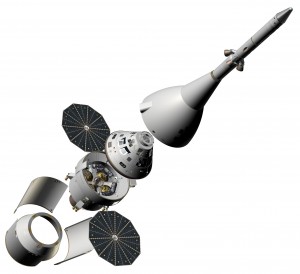The Orion spacecraft is the vehicle NASA plans to use to extend the reach of manned spaceflight beyond Low Earth Orbit. Originally, it would have been perched on top of the Ares I launch vehicle, which was tested . . . but then canceled. Now, it will be on top of the Delta IV Heavy rocket for missions to LEO – like getting crew to the International Space Station – and eventually boosted up by the Space Launch System for more far-flung destinations.
The basic stats for the spacecraft are as follows:
Diameter: 5m
Habitable Volume: 316 cubic feet (8.95 cubic meters)
Capsule Mass: 8913 kg
Service Module Mass: 12337 kg (7907 kg propellant)
Crew: 2-6
Delta-V: 1595 m/s
Endurance (with current service module configuration): 21.1 days
The cancellation of the Ares I led to a massive delay in the implementation of the system, and while the Space Launch System offers the opportunity to get much heavier payloads into orbit – in its ultimate configuration the SLS will lift more than the Saturn V – it is also hampered by opponents. It’s a shame that NASA’s SLS timeline isn’t more expedited, because there’s no telling what will happen to it in the hands of a new administration in 2017, just like there were no guarantees for Ares I and the Constellation program after 2008.
A lot of the opposition to SLS comes from space exploration societies that favor unmanned missions over manned missions. I find that short-sighted, especially since manned spaceflight is unique in the way it inspires the public (consider ISS Commander Chris Hadfield‘s tweets and videos which generates so much interest), and public support is key to the future of government funding for space projects – both manned and unmanned.
The current plan is for Orion to take the Delta IV Heavy up for a test next year, then the SLS will take it up for an uncrewed circumlunar mission in 2017. The best estimate for a manned Mars mission is August 2024, which would be pretty good if we were talking about new hardware all the way, but the SLS uses the Space Shuttle Main Engines in its first two stages and the Space Shuttle Solid Boosters on initial launch. If there was a robust schedule of flights before 2024 to the ISS and other destinations, it wouldn’t be a problem, but the test schedule is sparse at best because of budget constraints. While there were ten Apollo missions before Apollo 11, there are only four scheduled SLS missions before the possible Mars sample return mission.

